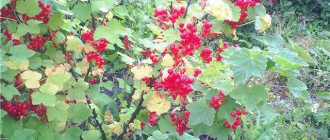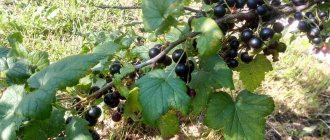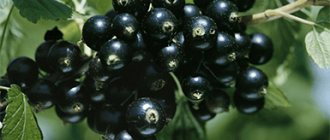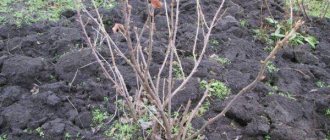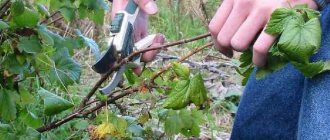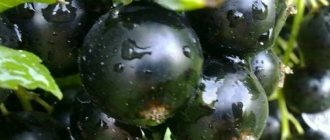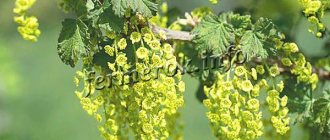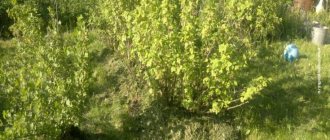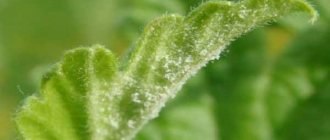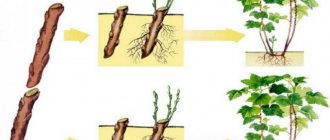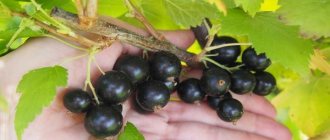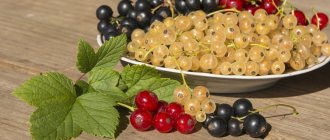Description of the blackcurrant variety Hercules
Hercules currants were brought to the NIISS named after M. A. Lisavenko. The author of the variety is L.N. Zabelina. To obtain it, we crossed the Plotnokistnaya currant (a hybrid of the Zoya and Pushistaya varieties) and a seedling obtained through open pollination of the Siberian subspecies from the Ilgumen River. Testing of the variety at the state level began in 2000, and in 2010 it was included in the State Register.
Black currant Hercules is recommended for cultivation in the Ural, Western and Eastern Siberian regions. In practice, it is grown in other regions of the country. The exception is the northernmost territories, where this late variety simply does not have time to ripen due to the short summer.
Currant Hercules forms tall, upright bushes with medium foliage. Adult specimens can reach 2.5 m. Growing shoots have a green color and a pinkish blush, high to medium thickness. After lignification, the color becomes light brown and has a slight sheen.
The buds of the black currant Hercules are medium in size, rounded-ovoid in shape. In the upper segments of the shoots they are deflected and collected in groups. Their color is light green with a pink blush.
The leaves of the Hercules variety are three-lobed and dense with small rounded teeth. They are large in size, bright green in color, and have a smooth surface without pubescence. The bases are deep, slit-shaped. The lobes are pointed, the middle one is wide, the basal ones are poorly developed. The leaves grow on thick petioles. Their length is medium and short, the color is light green, and there is pubescence. The petioles are located at an angle relative to the shoots.
Blackcurrant Hercules has medium-sized flowers. The petals are open and deflected, the color is cream. The sepals, which have a pink border, have the same color.
Currant Hercules forms long green clusters with slight drooping. Their thickness is average. There is one brush per node. Each one produces 8-12 berries on short, slightly pubescent stalks.
According to the description with photos and reviews of the black currant variety Hercules, its fruits are large in size. Their main characteristics:
- round shape;
- black color;
- low shine and light patina;
- dessert taste with sourness;
- dry tear;
- the skin is thin, but elastic and durable;
- the seeds are small and light brown, large in quantity;
- medium-sized falling calyxes;
- soluble solids content 18.4%;
- sugars in the composition occupy about 9%;
- in 100 g 177 mg of ascorbic acid;
- titratable acidity 2.2%.
Due to the large size of the berries, Hercules currants are easy to collect and process.
Comment! Black currant Hercules is self-fertile, so it does not need pollinators. At the same time, planting them nearby increases the yield and taste of the variety.
Characteristics
Late black currant Hercules is a promising variety. In many respects, it exceeded the breeders' expectations.
Drought resistance, frost resistance
Black currant Hercules belongs to frost resistance zone 4a. This means it can withstand temperatures down to -34.4°C. Flowers and buds of this variety are not afraid of return frosts.
Currant Hercules does not like drought, so it needs regular watering. This variety does not tolerate short-term lack of moisture as painfully as many other varieties.
Productivity
Black currant Hercules is a late variety. It begins to bear fruit in mid-August. The yield is high - 3.5-4 kg of berries can be collected from a bush. In industrial quantities this is 11 tons per hectare. The fruits can be collected using automated equipment.
Hercules blackcurrant berries do not shrink as they ripen if you provide them with competent and comprehensive care. The fruits ripen late, when the intense heat has already passed, so they will not bake in the sun if harvested in a timely manner.
Application area
The Hercules blackcurrant variety is considered a dessert variety. Its berries are good fresh and suitable for canning and freezing. The leaves are used in folk medicine and added to tea for aroma.
Hercules currant berries tolerate transportation well. This variety is suitable for long-term storage.
Harvesting and storage
In order for the harvest to be stored for a long time, it is important to follow the rules of proper berry picking. If you want to use the berries right now, you can pick them at any time. But if the berry is going to be stored, then it must be collected in dry weather, after the dew has disappeared. Pick the berries in tassels as carefully as possible. Place the berries in small baskets, preferably their width is greater than their height, so that the berries will not be damaged under their own weight.
Fresh berries can be stored in the refrigerator for up to two weeks; if you pick slightly unripe berries, their shelf life will increase, during which time they will have time to ripen. Never wash berries before placing them in the refrigerator.
If for some reason the berries get wet, they must be dried before storing. For storage, the berries are placed in an unsealed container so that air circulates between them. In addition, currants make excellent preserves, and the berries lend themselves well to freezing.
With proper care, Hercules blackcurrant will bring you large harvests of excellent taste and quality. You can easily grow this variety of currant in your own area.
Advantages and disadvantages of the Hercules currant variety
Many gardeners speak positively about Hercules blackcurrant. I am especially pleased with their good yield and berry size.
Black currant variety Hercules is unpretentious, it can be grown on different soils if they are fertile
pros
- high and stable yield;
- good frost resistance;
- large fruits;
- ease of care;
- long-term storage;
- resistance to most fungal diseases;
- high content of ascorbic and fruit acids;
- self-fertility;
- transportability.
Minuses
- vulnerability to kidney mite.
Diseases and pests
Hercules currants are not affected by anthracnose and septoria. In general, this currant is susceptible to few diseases and parasites, and by following some rules for their prevention, you will get rid of them for good.
- The bud mite is a small insect that overwinters inside the buds of plants. With the onset of warmth, the pest wakes up. Females lay eggs inside young buds, which later stop their development because of this. Signs of the presence of a mite on a bush are curliness and marbling. Infected buds resemble cabbage due to severe swelling. Methods of pest control include manual removal of affected buds, treatment with boiling water or special preparations. To prevent plant infection by bud mites, it is necessary to carry out sanitary pruning in a timely manner, plant only healthy seedlings, and timely removal of weeds from the beds.
- Currant glass - the larvae develop inside the stem of the plant, making tunnels there, as a result of which the berries dry out and the leaves turn yellow. You can fight it only with the help of drugs such as Fitoverm or Lepidocid. Prevention - timely pruning of affected shoots.
- The currant borer is a parasite that settles on a bush and slowly eats the stems of the plant. The eggs are laid on the surface of the branches, while clinging to them with mucus. Due to the activity of the pest, the plant weakens. The control method will be to remove the affected branches and treat them with calcium arsenic acid. The essence of preventing borer infection is proper and thorough care.
Landing
You can plant Hercules black currants in spring or autumn from April to October. It is better to plan work for the first half of September. If spring begins early and summer is too hot, then the bushes may not take root. In this case, it is better to plant them in the fall.
For this variety you need to choose an open, unshaded place. The soil must be fertile. If it is acidic, you need to add lime.
Currant seedlings should be selected that are healthy and without mechanical damage or rot. To prevent kidney mites, they should be placed in a solution for a day - 10 liters of water, 10 g of Agrovertin and 40 g of colloidal sulfur.
For planting, it is better to choose two-year-old seedlings with 2-3 shoots and a well-developed root system.
Hercules blackcurrant bushes should be planted at a distance of 1.5-2 m. You need to prepare holes or trenches with a depth of 0.3 m in advance. It is better to do this two months before planting. Further algorithm:
- Place fertilizers in the pit - compost, humus, horse manure. You can add wood ash or 50 g of potassium and 0.1 kg of superphosphate.
- Add a layer of fertile soil.
- Pour in 5 liters of warm water
- Install the seedling.
- Spread out the roots.
- Sprinkle with earth and compact it. Deepen the root collar by 5 cm.
- Pour in another 5 liters of warm water.
- Mulch the tree trunk circle.
Comment! It is recommended to install currant seedlings at an angle of 45°. This promotes rooting and rapid growth.
Immediately after planting, Hercules black currants should be trimmed to 5-6 buds.
Preparing for winter
Hercules is cold-resistant, however, it is better to cover the bushes in the winter. First, the shoots need to be bent to the ground in the direction of their growth and grouped in 3-5 pieces, then a board is laid on top and a brick on it. The tree trunk circle is sprinkled with rotted sawdust, leaves or sunflower husks. This way you will protect the bushes from frost and maintain moisture in the soil. After snow falls, transfer the material to the branches and lightly press down. If snow has not fallen, cover the bush with spruce branches of a coniferous tree or agrofibre.
Video: Preparing currant bushes for winter
Aftercare
Black currant Hercules requires comprehensive care. It includes the following activities:
- Regular watering. It is enough to carry it out once a week; you cannot flood the bushes. Moisturizing is especially important at the beginning of flowering, during the ripening of berries. It is necessary to water at the root.
- Systematic loosening of the soil after watering. This is done near the surface so as not to damage the root system.
- Feeding. Nitrogen is needed in spring. In summer, if growth, flowering or fruit set is poor, add 10 liters of a solution of water and cow manure 10:1 per 1 m². In the fall, 5 kg of compost, superphosphate and potassium sulfate are added to each bush.
- Mulching to retain moisture. You can use peat or compost.
- Pruning in spring before buds swell and in autumn before frost. It is necessary to cut the shoots to the root or leave the largest branch. Get rid of all old and diseased specimens. Branches lying on the ground must be trimmed. By the fifth year, the bush should have three old, young and two-year-old shoots.
Bushes need to be insulated only in regions with harsh winters. This measure is recommended in the first year of planting.
Reproduction methods
The most popular and convenient methods of propagating currants are vegetative. The easiest of them is propagation by layering. To do this, in early spring, find a branch no more than 2 years old that can be tilted down without damaging it. Under the selected branch, dig a hole 10–12 cm deep and bend the branch down so that its middle part is in the hole, and the top protrudes above the ground.
Don't forget to water the branch thoroughly. Over the summer it will grow into a powerful seedling, then it can be cut off from the parent bush. Then you can transplant the branch to the garden bed.
Propagation by lignified cuttings allows you to harvest seedlings even during winter frosts. To do this, at the end of autumn, branches are cut (cut on both sides) 18–20 cm long. Be sure to cut them before the onset of severe frosts. Cuttings are cut from annual shoots on 2-3 year old branches. It is better to cut them from the middle of the shoot, where it is 8–10 cm thick. Then treat the sections with warm paraffin or garden varnish.
Wrap the cuttings in moistened paper, then in plastic. Before planting, they should be stored by burying them in the snow or placing them in the refrigerator. In the spring, plant the cuttings in the beds, maintaining a distance of 15 cm. Before planting, the tip of the cutting is cut off, leaving an oblique cut.
When planting cuttings, two buds are left on the surface. Then water the beds thoroughly. Place arcs 40–50 cm high over the beds and cover with plastic film. You can remove it when the first leaves appear, then start watering the beds. In the fall you will receive seedlings 30–50 cm long with 1-2 shoots, then you can plant them in the garden bed.
Propagation by green cuttings is a longer and more energy-consuming process; its implementation requires a greenhouse or hotbed with a fog-forming function. Cuttings 5–10 cm long are cut from well-developed shoots, and two green leaves are left on each of them. It is advisable to immerse the base of the cuttings in a liquid growth stimulator for 12–14 hours. During the process, do not forget to ensure that the humidity level is high and the temperature is +18. +24°C.
